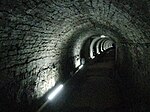South Shore Road power station
Coal-fired power stations in EnglandDemolished power stations in the United KingdomPower stations in North East EnglandUse British English from March 2014
South Shore Road power station was a coal-fired power station situated on the River Tyne at Gateshead, North East England. The station was built by the Durham Electrical Power Distribution Company in the early twentieth century. Ownership of the station was handed over to the Newcastle upon Tyne Electric Supply Company in June 1932 when they bought the Durham company. During the Second World War a warden post was situated at the power station. The site of the power station, near the Baltic Centre for Contemporary Art, has since been cleared, and an office development is being constructed on it.
Excerpt from the Wikipedia article South Shore Road power station (License: CC BY-SA 3.0, Authors).South Shore Road power station
South Shore Road,
Geographical coordinates (GPS) Address Nearby Places Show on map
Geographical coordinates (GPS)
| Latitude | Longitude |
|---|---|
| N 54.969 ° | E -1.595 ° |
Address
Baltic Place
South Shore Road
NE8 3AE
England, United Kingdom
Open on Google Maps










